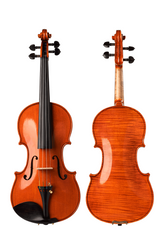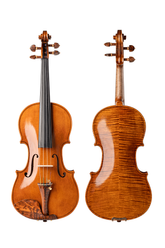String knowledge that violin beginners must know
As we all know, violin strings have a very important influence on the sound quality of the violin. So have you learned about violin strings in detail? Maybe, after you understand it, it can help you learn the violin better.
How many strings does a violin have?
Generally speaking, the violin has 4 strings, namely G, D, A, and E, therefore, it is also called a 4-string violin. (There are also different numbers of violins such as 5-string, 6-string, etc., but generally speaking, the violin is 4-string)
Features of G, D, A, and E strings:
G string: Thickness is the most prominent feature of this string, and it is more suitable for music styles that need to use sound to convey restrained emotions. It feels a little breathless in the low range, but it has a very rich performance when using a larger bow pressure or a faster bow in the high range.
D string: This is a string with the most abundant performance, but it has very high requirements for the difficulty of production, and a little flaw will affect the performance. Like the G string, it has some quiet and peaceful, with some mysterious and solemn emotional color.
A string: Soft affinity and bright, airy tone. There is a stronger bass, and the treble appears softer. Suitable for scores that require a soft and emotional tone. Especially note that this line is more prone to nasal sounds.
E string: It has a rich performance in the low range, especially when playing with other instruments. Bright and detailed sound in the high register. When playing, it should be noted that this wire is likely to produce thin or harsh sound quality.
What are violin strings made of?
Violin strings are generally divided into three materials: steel strings, nylon strings, and gut strings.
Steel-string: It is made of high carbon steel wire, which has the characteristics of wear resistance and pressure resistance. For beginner violinists, steel strings are durable enough for a lot of practice and have a smooth surface that reduces clutter. The tension is strong, and it can be easily tuned to the desired pitch. The volume is relatively loud. It is less affected by changes in external temperature, and the performance is relatively stable. But the performance of the sound is relatively general, but the good thing is that the price is relatively cheap. Generally speaking, beginner violin series use this kind of string, which can be replaced when you want to buy a better violin outfit.
Nylon strings: In fact, the difference between nylon strings and steel strings is that nylon strings are wrapped with a layer of nylon thin wire outside the steel strings. It features both the beautiful tone of gut strings and the stability of steel strings. However, it is also relatively easy to break and needs to be inspected and replaced regularly, and the cost is relatively expensive compared to steel strings.
Gut strings: Humans first used sheep intestines or tendons to make strings. Until the 19th century, gut strings were the only choice for violin instruments. The gut strings have a soft feel to the hand, the sound performance is very rich, the sound quality is beautiful and beautiful, and it is very charming. However, due to the greater stretch of gut strings, it will take a few days for the newly installed strings to stabilize. It is greatly affected by the outside temperature and requires careful protection. Of course, its price is also very expensive, and it is also easy to break. If you choose gut strings, you need to have enough budget.
As a beginner violinist, which strings are the best?
For the violin, there are only the best suitable strings, not the best strings. However, as a beginner, there is no way to choose the strings by yourself because you don't have a good understanding of the violin and strings. At this time, you can ask your teacher and choose according to the teacher's suggestion. Or you can directly buy the beginner violin series, both the price and the quality are the most suitable for beginners to practice. (There is no need to buy strings separately, extra strings will be given away)

Follow Fiddlover for more violin content.





